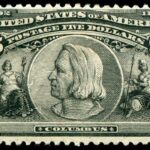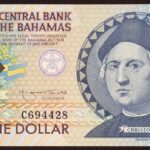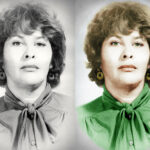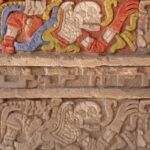“His discovery was a blunder; his blunder was a new world; the New World is his monument!”
Union Station is the primary transportation hub in Washington, D.C. Thousands pass through it daily but few stop to appreciate the impressive fountain that sits outside its entrance honoring Christopher Columbus and his contributions to the colonization of the American continents.

The basin of the fountain is more than 60 feet in diameter, dominated by a central shaft that rises more than 40 feet. Atop the central shaft is a globe surrounded by garlands and bald eagles at each corner. Columbus is on the southern side of the shaft, facing the Capitol Building. Depicted at 15 feet tall, arms crossed, he stands on the prow of the Santa Maria – his flagship on his first voyage to the Americas. The figurehead on the prow is a winged woman symbolizing Discovery. On the eastern side of the shaft is an aged, bearded man of European descent representing the Old World. On the western side is a Native American representing the New World. On the northern face of the shaft a medallion with the faces of King Ferdinand II and Queen Isabella I are carved in relief into the marble and below that is an inscription: TO / THE MEMORY OF / CHRISTOPHER COLUMBUS / WHOSE HIGH FAITH / AND / INDOMITABLE COURAGE / GAVE TO MANKIND / A NEW WORLD / BORN MCDXXXVI / DIED MDIV. On the eastern and western edges of the fountain are two couchant (lying down with the head up) lions. The three flagpoles north of the fountain represent the three ships on Columbus’s first voyage.

Momentum to build a monument to Columbus began after the 1893 Columbian Exposition marking the 400th anniversary of Columbus’ first voyage. The Knights of Columbus lobbied for it as well, and in 1907 Congress approved $100,000 for its construction. The work was completed in 1912 and it was dedicated in June. Coordinated by the Knights of Columbus, the ceremony was a large affair that lasted through the weekend. The parade for the ceremony had over 80,000 people in it. The viewing stands, which seated 20,000, were filled to capacity and the streets were filled from Union Station to the Capitol Building. President Taft presided over the ceremony with Italian Ambassador Cusania Confalonieri and many Catholic dignitaries.

The fountain was created by artist Lorado Taft (a distant relation of the president) and architect Daniel Burnham. Taft is best remembered for his fountains, especially the Fountain of Time and the Fountain of the Great Lakes, both in Chicago. Burnham is remembered for designing the famed Flatiron Building in New York and Union Station in Washington, D.C.

As early as 1485 Columbus had begun lobbying the monarchs of Europe to finance his voyage, which he believed would take him to Japan. Contrary to popular belief, no one with an education believed the world was flat. The confusion lay in not knowing exactly how big the planet was. Although the Greek scholar Eratosthenes of Cyrene correctly calculated its circumference in the 3rd century BCE, there was confusion in Columbus’ time over the correct conversion of the older units of measure into modern ones. Columbus also believed the landmass of Asia to be nearly 75 percent larger than it actually was, so when he made his first landfall in what is now the Bahamas, he thought he was just to the east of Japan.

Columbus was not the first European to reach the New World – that honor belongs to Leif Erikson – but Columbus’ voyages established a lasting European presence in the New World, generated great interest throughout Europe, and marked the beginning of the era of colonialism. In 1497 John Cabot was exploring the coast of Newfoundland for the British. Amerigo Vespucci’s name would be given to the continents in 1507. In 1513 Vasco de Balboa first set eyes upon the Pacific Ocean. By 1535, the Spanish had conquered the two largest American empires, the Inca and the Aztec. And in 1607, 100 years after Columbus’ death, the English established their first permanent settlement at Jamestown, Virginia.
In the more than 500 years since his death, the legacy of Columbus has taken a tumultuous path. His eight years as governor of the first Spanish colonies were marked by avarice and tyranny*. He defied the commands of his pope and his king by enslaving thousands of natives instead of converting them. Tragically, this type of treatment became normalized, and this aspect of his character was long overlooked. Even today, the popular myth of Columbus is one of a brave explorer gifting the New World to Europeans.
Today Columbus’ legacy can be seen in place names around the Americas, such as the U.S. capital, the District of Columbia, the state capitals Columbus, Ohio, and Columbia, South Carolina, and the South American nation of Colombia. He has also been featured on the stamps and currency of many European and American countries. The U.S. celebrates a national holiday in his honor every October, and most countries in Latin America do as well.

*Columbus made four voyages to the New World between 1492 and 1503. On his first trip he established the colony of La Navidad on the north coast of Haiti. Upon his return he wrote a letter to Ferdinand and Isabella which was widely published around Europe. The contents of the letter greatly exaggerated his discoveries in order to generate more demand for a second expedition.

After less than a year back in Europe, Columbus’ second expedition set out with a fleet of 17 ships. He returned to find the original settlement destroyed and all who stayed behind dead. He built a new colony – La Isabela – in present day Dominican Republic which lasted until gold was found elsewhere and the city was abandoned. During this trip, Columbus enslaved hundreds of people and established a tribute system whereby the natives who were not enslaved had a quota of gold to deliver every three months or have their hands cut off. When Columbus left in early 1496, it is estimated that the natives of Hispaniola (the island occupied by Haiti and the Dominican Republic) had lost two-thirds of their population to violence, famine, and disease.
His third expedition left Spain in 1498. Columbus sailed much further south and set foot on South America, realizing that it was a new continent due to the volume of the Orinoco River, but still clinging to the belief that it was connected to the Asian landmass. He then returned to Hispaniola to find it in the midst of rebellion, which he quelled brutally. When the Spanish crown sent in a governor to control the situation, Columbus was arrested and sent back to Spain in chains in 1500. His treatment of the natives and the Europeans was so brutal that even his allies spoke against him.
Columbus was eventually freed and he returned to the Americas a final time in 1502. His goal this time was to find a rumored strait to another ocean. He explored the Caribbean coast from Honduras south to Panama but found nothing. On his way back to Hispaniola a storm damaged his ships and stranded him and his crew on Jamaica for more than a year before they were rescued. Columbus returned to Spain not long after, in 1504, and he died less than two years later in 1506.
Resources used for this article:
https://en.wikipedia.org/wiki/Columbus_Fountain
http://dcist.com/2008/03/revisiting_the_5.php
http://query.nytimes.com/mem/archive-free/pdf?res=9F02E2DA1E3CE633A25751C0A9609C946396D6CF
https://en.wikipedia.org/wiki/Lorado_Taft
https://en.wikipedia.org/wiki/Daniel_Burnham
http://query.nytimes.com/mem/archive-free/pdf?res=9F02E2DA1E3CE633A25751C0A9609C946396D6CF




